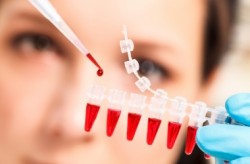Hemoglobin is the main protein of the respiratory cycle. It participates in oxygen transfer processes from respiratory organs to tissues, and carbon dioxide in the opposite direction. Hemoglobin is contained in human blood erythocytes, to assess the hemoglobin content use general blood analysis. Normally, the hemoglobin indicator in women is 120-140 g / l (grams per liter) and may vary slightly depending on the state of the woman, monthly cycles and loads on the body.
Causes of increasing hemoglobin

Sometimes the high hemoglobin content may be due to the effect of certain human actions, circumstances or environmental factors:
- This is possible with intensive physical exertion among athletes (especially in skiers, skating, marathontes), as well as due to the reception of anabolic steroids.
- In high-altitude conditions, a large amount of hemoglobin is produced in the blood, thus the body compensates for the increased load on the body associated with the lack of oxygen at large altitudes. People whose profession is associated with frequent flights (in women - pilots, flight attendants), as well as climbers, there may be an increased level of hemoglobin.
- At the occurrence of pregnancy, a hormonal restructuring in the body of a woman occurs, which can provoke races of hemoglobin levels. During this period, occasionally may be observed in blood hemoglobin content of about 150-160 g / l.
- Unlimited smoking - the smokers often increased the hemoglobin indicators, this is due to the influence of carbon monoxide to the body.
- The so-called false elevated hemoglobin level due to heat and abundant sweating, dehydration (Dehydration). After establishing the fluid consumption mode, the hemoglobin level comes to normal.
- Due to exhaustion, burns, Strong vomiting.
- Improving hemoglobin may occur due to admission multivitamin complexes or glage preparations.
If the above factors are excluded, our site recommends not to try to independently guess the causes of high hemoglobin, but to refer to a qualified specialist.
Medical examination is required to eliminate possible pathologies:
- cardiovascular failure;
- diseases of the respiratory system (chronic Bronchitov, Pneumonia, pneumosclerosis);
- Disorders of the intestine, atrophy of the gastric mucosa;
- poisoning I Toxicosis;
- oncological diseases;
- erythrocytosis (excess of physiological norms of the number of erythrocytes in the blood due to the decrease in the liquid part of the blood) and hemoglobinemia (increasing the hemoglobin content in the blood plasma);
- hemochromatosis (hereditary genetic impairment of iron exchange in the body, in which iron is overly accumulated in organs and tissues) - about 10 percent of the population are carriers of this gene, and the probability of developing the disease is about 0.3 percent);
- Sugar diabetes (An increase in the glycated hemoglobin occurs due to the overaction of blood glucose).
High Level Symptoms Hemoglobin

The rate of hemoglobin in the blood of pregnant women - 110-130 g / l, which is slightly lower physiological norms for women in general. In the first half of pregnancy, the future mother, the hemoglobin level remains almost unchanged, in the second half the volume of circulating blood is changing, to which the body can react by a decrease in or in some cases an increase in hemoglobin levels. Hemoglobin growth can be associated, including with the reception of a complex of polyvitamins and minerals with increased content of iron preparations. In this case, after the cancellation of polyvitamins, hemoglobin is returned to the average.
When a high level of hemoglobin in the blood in pregnant women are appointed additional surveys, such as blood chemistry And general analysis of urine, as well as consultation of specialists (perhaps it will be necessary to inspect the therapist, endocrinologist, cardiologist, urologist, oncologist).
Possible disorders during pregnancy associated with the high level of hemoglobin in the blood of a pregnant woman can be:
- Chronic hypoxia fruit and the delay of intrauterine development;
- Failure to pregnancy, intrauterine death;
- Increased risk of thrombosis in a pregnant woman and women in labor.
These complications are associated with the strengthening of blood lungs and viscosity due to the increased hemoglobin content in the blood.
Preventive measures during pregnancy:
- timely registerment of women's consultation, regular control of the overall blood test (when registered and at different times of pregnancy);
- It is necessary to abandon bad habits;
- conducting a thorough medical examination before pregnancy planning;
- Healthy lifestyle, prevention and timely treatment of chronic diseases.
How to normalize hemoglobin level

First of all, based on diagnostic surveys and identified diseases, drug treatment is appointed. The reception of drugs that dilute blood stimulating normal blood formation. The treatment regimen and a specific diet at the same time the doctor offers.
It is also necessary to mention some of the basics that it is useful to know and take into account every person. With dehydration due to heavy physical exertion, the exhausting heat and increased sweating of the diet should be aimed at restoring the liquid balance. At the same time, our site recommends changing the power mode, increase the use of liquid, drink little, but often. The rate of fluid consumption is at least 40 milliliters per day at the rate of a kilogram of the body, including all the liquid from food and drink. It is advisable to limit the use of meat, heavy and fatty dishes, including lightweight cold soups and more vegetables, as well as seafood and dairy dishes.
In hemakhromatosis (impaired iron metabolism in the body) should be minimized in its diet consumption of high iron products:
- Red meat, especially beef, rabbit (as part of veal, lamb and pork Iron indicators are significantly lower), meat offal;
- Craises (buckwheat, oat, pearl, bone, rice and millet);
- legumes (beans, peas);
- Apples, pomegranate, black currant, plums, pears, persimmon, red berries (raspberry, cherry, strawberry);
- butter, eggs, cheese;
- Sweets, fat and smoked.
Based on the foregoing, MyMedinform.COM recommends consistently refer to the state of health, in particular to the condition and quality of blood. Accordingly, it is necessary at least once a year, check the hemoglobin indicator using a general analysis of blood, and when identifying deviations from the norms, consult with specialists, since the elevated level of hemoglobin in the blood may be a consequence of various violations in the body.









